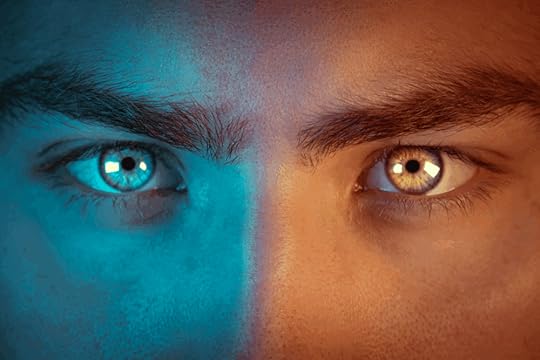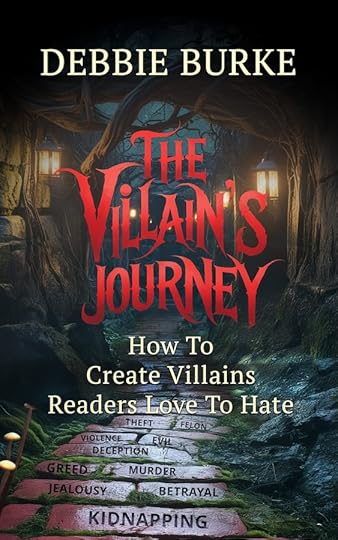The Villain Is the Hero of Their Own Story
 Photo by Gabriel Meinert on Unsplash
Photo by Gabriel Meinert on UnsplashToday’s post is excerpted from The Villain’s Journey: How to Create Villains Readers Love to Hate by Debbie Burke.
As Christopher Vogler and other wise authors have observed, villains are the heroes of their own stories. Villains and antagonists have their own goals, needs, and desires to fulfill. They feel justified that the path they pursue is the right and righteous one. From their point of view, the so-called “hero” of a story is their opponent or enemy.
The Writer’s Journey: Mythic Structure for Writers by Christopher Vogler is the classic textbook for screenwriters and novelists that explains the Hero’s Journey. Since villains usually consider themselves heroes, they can also go through the same stages heroes do, with some important variations to be discussed a little later.
Here are the 12 stages the hero goes through:
The Ordinary World: the hero is seen in their everyday lifeThe Call to Adventure: the initiating incident of the storyRefusal of the Call: the hero experiences some hesitation to answer the callMeeting with the Mentor: the hero gains the supplies, knowledge, and confidence needed to commence the adventureCrossing the First Threshold: the hero commits wholeheartedly to the adventureTests, Allies, and Enemies: the hero explores the special world, faces trials, and makes friends and enemiesApproach to the Innermost Cave: the hero nears the center of the story and the special worldThe Ordeal: the hero faces the greatest challenge yet and experiences death and rebirthReward: the hero experiences the consequences of surviving deathThe Road Back: the hero returns to the ordinary world or continues to an ultimate destinationThe Resurrection: the hero experiences a final moment of death and rebirth so they are pure when they reenter the ordinary worldReturn with the Elixir: the hero returns with something to improve the ordinary worldVillains follow similar stepsThey live in their ordinary world, although that world may be one of debasement and/or crime. What is your character’s ordinary world? Poverty, abuse, boredom, etc.?They are called to adventure. The adventure may be an illegal act, like knocking over an armored car, stealing jewelry from wealthy socialites, or kidnapping for ransom. Or the sleuth-protagonist begins chasing them. What is your character’s call to adventure?They may be reluctant at first and refuse the call.They meet a mentor who influences or trains them in the intricacies of crime, teaching ways to avoid getting caught. Does your character meet a mentor who guides them into villainy? Describe the mentor.They cross the first threshold into the special world by breaking the law. Now there is no turning back. What is their first crime? Or their first action that results in becoming a criminal?They meet others in the special world who are enemies and obstacles to achieving their goal. They may find accomplices to help them attack their enemies. Does your character have enemies? Who are they? If they have allies, where do those allies come from?They approach the innermost cave, prepared to commit the heist, assassination, terrorist attack, etc. As your character faces this brink, what do they feel? Are they afraid? Reluctant? Eager and excited?They meet their opponents in a showdown where they either achieve their goal or they fail. What is the outcome of your character’s showdown?Starting with Step #9, the villain’s journey may take a different route that leads to a dead end for them. When the hero defeats the villain, good conquers evil. The villain is vanquished by death, capture, incapacitation, imprisonment, or other punishment for their crimes. Game over. They receive their just deserts.
When the hero wins and the villain loses, readers and audiences cheer. They love to see bad guys and gals pay for the wrong they’ve done. They’re reassured that justice can prevail and safety and security can be restored. Understandably, this conclusion is the most popular in commercial fiction.
However, for the villain, Step #9 may not lead to a dead end. Instead, the villain may vanquish the hero and seize the reward. In Step #10, the villain then returns to their ordinary world or ultimate destination with the prize. They are likely to skip Step #11, resurrection. They do not experience spiritual death nor enlightenment. They are not purified by the experiences they have on their journey. They remain unchanged, although they usually wind up richer and/or more powerful.
Many villains skip Step #12 altogether. They are selfish about the reward, either keeping it for themselves or possibly sharing with criminal cohorts. This ending occurs in noir fiction and, although depressing, can be satisfying. An example is the 1974 Oscar-winning film Chinatown. Villain Noah Cross remains wealthy, powerful, and untouchable. The battered detective hero Jake Gittes is told by his partner: “Forget it, Jake. It’s Chinatown.” In other words, nothing can be done to change corruption because the controlling hierarchy is inherently corrupt.
The Usual Suspects, a 1995 film directed by Brian Singer, features an elaborate con job where investigators are sent on a wild goose chase seeking the elusive crime boss Keyser Söze. The complex revenge plot winds through twists and turns with a shocker ending that reveals all assumptions were illusions, not reality. The real villain convinces everyone he doesn’t exist and walks away, successful, cynical, and satisfied. Viewers of the film were also satisfied. The film won two Oscars, including Best Original Screenplay by Christopher McQuarrie.
Another ending variation for the Villain’s Journey is Conversion and Redemption. This ending is rarer but is immensely satisfying to readers. In Step #11, the villain has a revelation that the way they have lived is wrong. They endure spiritual death and rebirth, resulting in purification and resurrection. They are changed and redeemed. In Step #12, they share their wisdom with the community. The classic redeemed villain is Ebenezer Scrooge from A Christmas Carol, the 1843 novella by Charles Dickens.

Bestselling mystery and romantic suspense author Allison Brennan offers an additional take on the journeys of heroes and villains: “Everyone talks about the heroes and their backstory and conflict, but they often forget that the villain needs it all and more—we need to figure out how they became so evil.”
How will your villain end their journey?
Do they fail?
Do they succeed?
Do they come to a realization, and change?
Note from Jane: If you enjoyed this post, be sure to check out The Villain’s Journey: How to Create Villains Readers Love to Hate by Debbie Burke.
Jane Friedman
- Jane Friedman's profile
- 1885 followers



